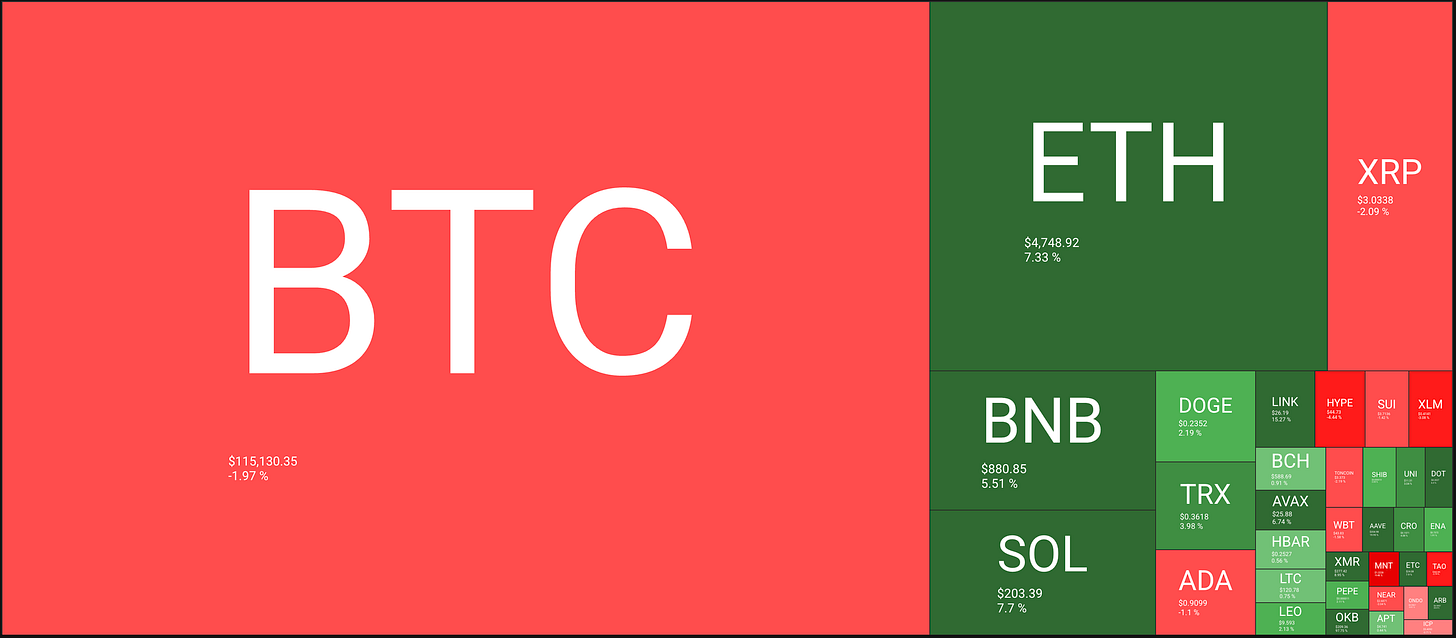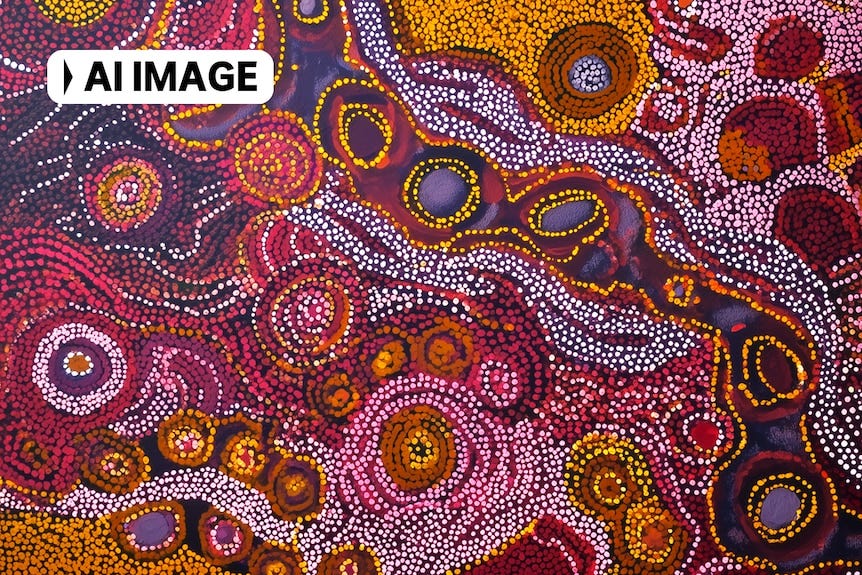Weekly Journal: From Culture to Clickbait: Indigenous Art at Risk from AI
[6 min read] Your weekend guide to getting ahead on the digital frontier. This week explores how indigenous culture will need protection in the metaverse, in the age of AI.
Welcome to this week’s Weekly Journal 📔, your guide to the latest news & innovation in emerging technology, digital assets, and our exciting path to the Metaverse. This is week 142 of the 520 weeks of newsletters I have committed to, a decade of documenting our physical and digital lives converge. New subscribers are encouraged to check out the history & purpose of this newsletter as well as the archive.
- Ryan
🌐 Digital Assets Market Update
To me, the Metaverse is the convergence of physical & virtual lives. As we work, play and socialise in virtual worlds, we need virtual currencies & assets. These have now reached mainstream finance as a defined asset class:
🔥🗺️Heat map shows the 7 day change in price (red down, green up) and block size is market cap.
🎭 Crypto Fear and Greed Index is an insight into the underlying psychological forces that drives the market’s volatility. Sentiment reveals itself across various channels—from social media activity to Google search trends—and when analysed alongside market data, these signals provide meaningful insight into the prevailing investment climate. The Fear & Greed Index aggregates these inputs, assigning weighted value to each, and distils them into a single, unified score.
🗞️ Metaverse news from this week:
Meta’s Hypernova Glasses: The $70B Bet That Could Make the Metaverse Mainstream
Meta is preparing to launch its Hypernova AR smart glasses this September, a move widely seen as the company’s most important step yet in making its $70 billion metaverse gamble pay off. The glasses blend fashion and function through Meta’s partnership with EssilorLuxottica (Ray-Ban, Oakley, Prada), ensuring stylish frames and global distribution. A neural wristband from Meta’s CTRL Labs powers subtle, gesture-based controls, solving one of AR’s biggest adoption hurdles: social awkwardness. Paired with Meta’s AI assistant and a monocular HUD, the glasses aim to become a proactive “personal superintelligence.”
At USD$800, the Hypernova undercuts rivals and directly challenges the smartphone market. Tethered to phones via the Meta View app, the glasses are designed as a bridge to a future where AR could replace mobile devices altogether.
Beyond hardware, Hypernova serves as a gateway to Horizon OS, Meta’s open platform for developers — a playbook reminiscent of Android’s rise. Early adoption will generate valuable data to refine AI models and prepare successors like Hypernova 2 and Project Orion.
Metaverse Lens: If successful, Hypernova could become the mass-market interface that the metaverse has long lacked. By embedding AI-driven personalisation into everyday eyewear, Meta is attempting to shift the metaverse from a speculative future into a lived reality — not a place you log into, but a layer of digital life that follows you everywhere.
📖 Read of the week: Metaverse for Corporate Training: The Ultimate Game-Changer or Just Hype?
By Samden Lama Dukpa | April 2025
While the consumer metaverse has struggled to gain traction, enterprises are finding real value in immersive training. Industries from healthcare to manufacturing are reporting tangible ROI — faster onboarding, safer simulations, and shorter product cycles — through VR modules and digital twins.
Key drivers include:
Generative AI & Digital Humans enabling hyper-personalised training.
Broader corporate buy-in, with PwC predicting training and onboarding as the leading business use case.
Strong ROI cases, from law enforcement simulations cutting decision-making times to manufacturers halving prototype cycles.
Challenges remain — privacy, accessibility, cost, and ethics — but momentum is clear: the metaverse is quietly shifting from hype to mission-critical enterprise strategy.
🎥 Watch of the week:
Borderless online communities need borderless digital money - so Stablecoins will at a critical role in the emerging metaverse.
Last month, in a bipartisan vote, the Senate passed the GENIUS Act, creating a regulatory framework for stablecoins. Dante Disparte, chief strategy officer at the financial technology company Circle, joins "The Takeout" to explain how stablecoins work and what the Senate's legislation means for the cryptocurrency.
AI Spotlight 🎨🤖🎵✍🏼: Calls to Protect Indigenous Culture from AI ‘Cultural Theft’
In the Metaverse, AI will be critical for creating intelligent virtual environments and avatars that can understand and respond to users with human-like cognition and natural interactions.
AI image models can now replicate Aboriginal and Torres Strait Islander art styles in seconds — but Indigenous leaders warn this is cultural theft. Legal expert Dr Terri Janke says AI “has no Dreaming, no kinship, no obligations” and risks flattening rich cultural traditions into generic dot paintings for commercial resale. Tests by ABC showed Midjourney producing inauthentic “Dreamtime” images of Ngunnawal country, despite dot painting not being part of that culture. Elders like Jude Barlow fear AI homogenises distinct languages, songs, and stories without consent. Already, AI-generated “Aboriginal art” is being sold on Etsy, Adobe Stock, and even Temu. With tourist demand for Indigenous art topping $78m annually — and 75% of pieces already inauthentic — pressure is growing for laws to protect Indigenous Cultural and Intellectual Property. For now, AI companies admit they have not consulted First Nations peoples, leaving communities to call for stronger guardrails before more stories and symbols are taken without permission.
To establish how quickly and accurately an Indigenous-themed image could be created, the ABC used ChatGPT to write a generative prompt for the Midjourney AI model.
Highly detailed Central Australian Aboriginal dot painting, inspired by Dreamtime stories and songlines, intricate organic patterns with vibrant earth tones, ochres, reds, yellows, contrasted with deep purples and midnight blues, asymmetric flowing composition, layered texture evoking hand-painted acrylic on canvas, capturing traditional symbolism and rich cultural heritage, authentic Indigenous art style, ultra-realistic, 8k resolution, museum-quality.
There were no guidelines, guardrails or warnings that indicated Midjourney's AI model had any barriers to creating the images we've used in this story.
That’s all for this week! If you have any organisations in mind that could benefit from keynotes about emerging technology, be sure to reach out. Public speaking is one of many services I offer.




